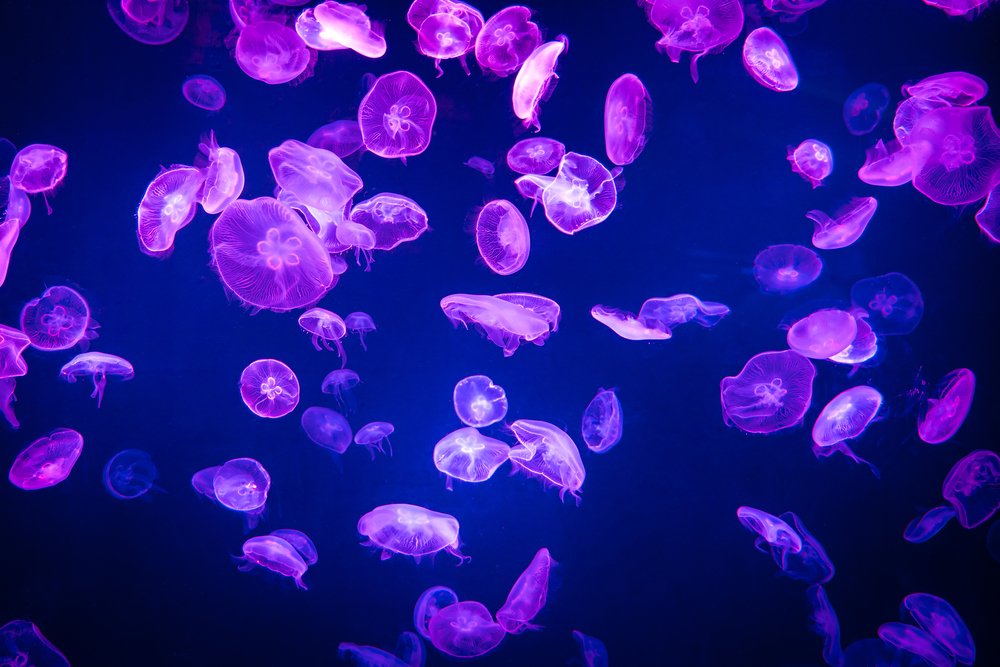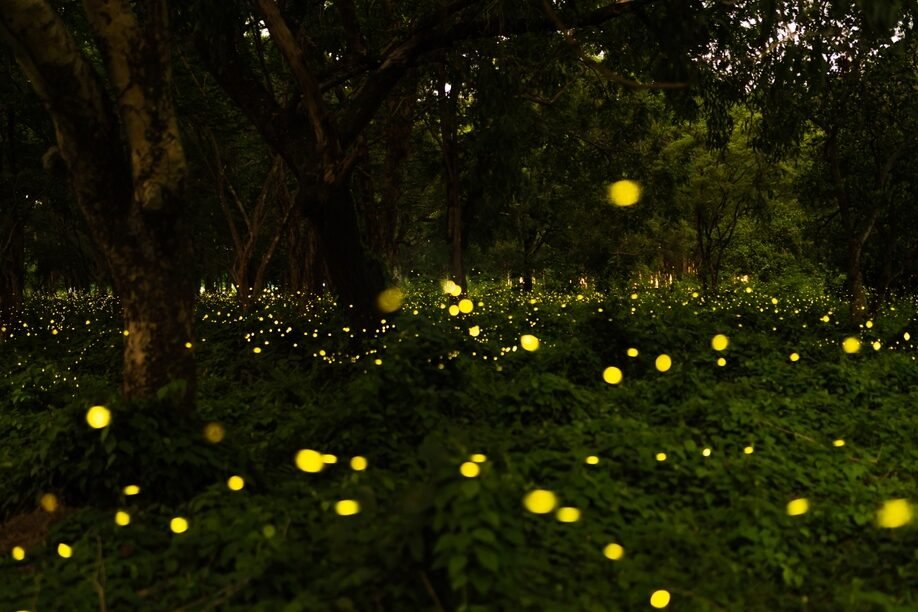Glowing Helps Animals Find Mates

Imagine being in the deep, dark ocean where you cannot see your hand in front of your face. In a place like that, finding a mate would be almost impossible without a little extra help. That is where glowing comes in. Many animals, especially those in the deep sea, use bioluminescence their ability to produce light as a way to attract potential partners.
Marine biologists explain that these flashes, twinkles, and steady glows act like a beacon in the darkness, signaling readiness to mate or advertising their presence. Some species even have elaborate light displays, like a dance, to impress mates. In a world where sight is limited, glowing is a powerful way to make connections. Without it, many deep-sea species might never find each other in the vast blackness, and life in the darkest parts of the ocean could not survive as it does today.
It Helps Animals Hunt for Food
In the pitch-black depths of oceans or in dark caves, finding food is no easy task. Some animals have evolved the ability to glow in the dark to lure their prey closer or to illuminate their surroundings just enough to catch a meal. It is like carrying around a living flashlight or setting a perfect glowing trap.
Experts on marine ecosystems point out that anglerfish are a perfect example. They have a glowing lure dangling from their foreheads that attracts smaller fish right into their mouths. Other creatures, like certain squid, use sudden bursts of light to expose hidden prey. For animals living in near-total darkness, bioluminescence turns the challenge of finding dinner into a brilliant advantage. It shows how evolution has created ingenious solutions in the harshest environments on Earth.
Glowing Can Be a Defense Mechanism
Sometimes, lighting up in the dark is not about catching food but avoiding becoming food. Many animals use their glow to confuse predators, startle them, or slip away unnoticed. When attacked, some squid and shrimp release a cloud of glowing fluid, much like how others might squirt ink. The bright distraction gives them precious seconds to escape.
Biologists who study defense behaviors explain that other animals might flash suddenly to disorient predators or even make themselves seem larger and more threatening than they really are. For some, glowing is like shouting “look over there” while making a getaway in the opposite direction. In the underwater world where every second counts, this clever use of bioluminescence can mean the difference between life and death.
Some Animals Glow to Camouflage Themselves
At first, it might seem strange that glowing could help an animal hide, but in certain parts of the ocean, that is exactly what happens. In the midwater zones of the ocean, faint light still filters down from the surface. Predators looking upward can spot the silhouettes of prey easily — unless those prey have a trick up their sleeves.
Scientists explain that some animals, like certain species of squid and small fish, use a technique called counter-illumination. They glow just enough on their bellies to match the light coming from above, effectively erasing their shadow. To a predator lurking below, they blend in with the background light and become almost invisible. It is a perfect natural invisibility cloak powered by bioluminescence, helping these creatures slip through the dangers of the ocean undetected.
Bioluminescence Is a Chemical Reaction
The glow that animals produce is not magic. It is chemistry at work. Bioluminescence happens when specific chemicals inside an animal’s body react together to release energy in the form of light. The key ingredients usually include a molecule called luciferin and an enzyme called luciferase. When these two mix with oxygen, a chemical reaction produces a soft, often bluish light.
Biochemists point out that the beauty of bioluminescence is in how efficient it is. Unlike a regular light bulb that gives off both light and heat, bioluminescent reactions produce very little heat. This “cold light” means animals can glow without wasting energy or overheating, which is crucial for survival in delicate or high-pressure environments like the deep ocean. Nature figured out how to create perfect, sustainable light long before humans ever dreamed of LEDs.
Different Environments Create Different Types of Glow

Not all glowing creatures live underwater. Fireflies lighting up summer nights are perhaps the most familiar example of bioluminescence on land. In caves, glowworms dangle sticky threads of light to trap insects. Even some types of fungi on forest floors emit a faint green glow, sometimes called “foxfire,” guiding insects that help them spread their spores.
Ecologists explain that bioluminescence has evolved independently many times in different environments. Whether it is the crushing depths of the ocean, humid forests, or damp caves, animals and plants have found creative ways to use light for survival. Each habitat shapes the style, color, and purpose of the glow, showing just how versatile and powerful this adaptation can be. It is one of nature’s greatest examples of innovation, tailored perfectly to fit the needs of each living thing that wields it.
Some Species Use Glowing to Communicate
In the animal kingdom, communication is not just about sounds or body language. For many glowing creatures, light is a language all its own. Some animals use bioluminescence to send signals to others of their kind, helping them coordinate movements, defend territory, or warn each other of danger. It’s a form of messaging that works perfectly in places where visibility is low and sound doesn’t travel well.
Researchers studying animal behavior note that certain deep-sea squid flash patterns of light across their bodies to signal aggression or readiness to mate. Fireflies on land are another classic example — each species has its own flash pattern, allowing them to find compatible mates even in large mixed swarms. These light-based signals are precise and purposeful, fine-tuned over generations. In environments where other forms of communication are unreliable, bioluminescence becomes a silent but powerful voice in the dark.
Evolution Has Repeatedly Invented Bioluminescence
One of the most fascinating things about glowing animals is how many times bioluminescence has evolved across completely different species. It’s not something that happened once and spread everywhere. Instead, it popped up independently in fish, insects, fungi, bacteria, jellyfish, and more. That kind of repeated evolution is a huge clue that glowing is not just beautiful — it’s incredibly useful for survival.
Evolutionary biologists explain that when a trait appears in many unrelated lineages, it’s often because that trait gives a strong advantage in the environment. Whether it’s used to attract mates, hide from predators, or catch dinner, bioluminescence has proven to be an incredibly flexible tool. That might explain why it’s so common in the deep sea, where sunlight doesn’t reach and organisms must find new ways to adapt. Nature keeps reinventing light — and every time, it works a little differently.
Some Animals Borrow Their Glow
Not all creatures that glow in the dark produce the light themselves. Some, like certain types of fish and sea slugs, rely on glowing bacteria to do the job. These organisms have formed symbiotic relationships, meaning both the host and the glowing bacteria benefit from the partnership. The animal gets a useful glow for attracting prey or mates, while the bacteria get a safe home and a steady food supply.
Marine scientists have found that flashlight fish, for example, house glowing bacteria in special pouches near their eyes. They can even shut the light off by covering it with a flap of skin, using it almost like a natural flashlight. This partnership between host and microbe is a clever shortcut to bioluminescence. Instead of evolving the glow themselves, these animals let bacteria do the work. It’s yet another example of how diverse and resourceful nature can be in solving life’s problems — with or without a built-in light switch.
Glowing Helps Track Movement in the Dark
In some species, the glow serves as a tool for spatial awareness. Instead of using it for communication or hunting, these animals might use their bioluminescence to sense motion, mark territory, or stay connected with a group. In the dark depths of the sea or thick forest, even a little bit of glow can provide enough feedback to help a creature know where it’s going.
Experts in sensory biology suggest that certain types of plankton, for instance, light up when disturbed — not just to scare predators but also to detect what’s moving around them. In larger animals, the ability to see another glowing body just ahead can help coordinate travel or school movement, much like taillights on a car in foggy weather. It’s a subtle but effective way to stay in sync without needing constant visual clarity or direct contact. In these cases, light becomes a kind of radar in the shadows.
Some Creatures Glow Just Once in a Lifetime
Not all glowing is ongoing. For some species, bioluminescence is a one-time event, often tied to a specific moment like reproduction. These single-use light shows are timed with astonishing precision and usually happen en masse, transforming beaches or waters into glowing spectacles for just a few magical hours.
Marine ecologists have observed that some types of worms, crustaceans, and even corals produce bursts of glowing chemicals during mating seasons. These displays are not just stunning to look at — they serve a vital purpose in helping large populations synchronize their reproductive efforts. When thousands of individuals glow at once, it increases the odds that eggs and sperm meet successfully. It’s nature’s way of throwing a carefully timed party, complete with dazzling light effects and life-changing consequences.
Humans Are Learning from Glowing Animals

Glowing creatures have sparked more than just curiosity — they’ve inspired major breakthroughs in science and technology. One of the biggest came from jellyfish, whose bioluminescent proteins have become essential tools in genetic research. Scientists have used these proteins to track genes, monitor cell behavior, and even develop new cancer treatments.
Biotechnologists continue to explore how the chemistry of bioluminescence could help us create better medical diagnostics, environmental sensors, or low-energy lighting. What began as a natural defense or mating tool for animals is now influencing how we tackle real-world challenges. These glowing species remind us that evolution’s weirdest tricks often hold the keys to our most advanced innovations. By looking to the natural world — especially in its darkest corners — we are finding new ways to light our path forward.
